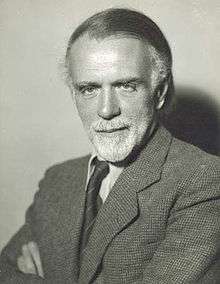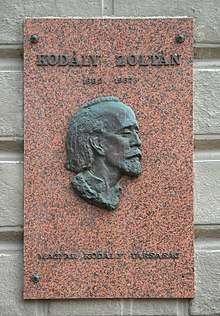Zoltán Kodály
Zoltán Kodály (/ˈkoʊdaɪ/; Hungarian: Kodály Zoltán, pronounced [ˈkodaːj ˈzoltaːn]; 16 December 1882 – 6 March 1967) was a Hungarian composer, ethnomusicologist, pedagogue, linguist, and philosopher. He is well known internationally as the creator of the Kodály Method.
Life
Born in Kecskemét, Hungary, Kodály learned to play the violin as a child.
In 1905 he visited remote villages to collect songs, recording them on phonograph cylinders. In 1906 he wrote a thesis on Hungarian folk song, "Strophic Construction in Hungarian Folksong". At around this time Kodály met fellow composer and compatriot Béla Bartók, whom he took under his wing and introduced to some of the methods involved in folk song collecting. The two became lifelong friends and champions of each other's music.

All these works show great originality of form and content, a very interesting blend of highly sophisticated mastery of the western European style of music, including classical, late-romantic, impressionistic and modernist traditions, and on the other hand a profound knowledge and respect for the folk music of Hungary (including the Hungarian-inhabited areas of modern-day Slovakia and Romania, as those territories were part of Hungary). Partly because of the Great War and subsequent major geopolitical changes in the region, and partly because of a naturally rather diffident temperament in youth, Kodály had no major public success until 1923. This was the year when one of his best-known pieces, Psalmus Hungaricus, was given its first performance at a concert to celebrate the fiftieth anniversary of the union of Buda and Pest (Bartók's Dance Suite premiered on the same occasion.)
Kodály's first wife was Emma Gruber (née Schlesinger, later Sándor), the dedicatee of Ernő Dohnányi's Waltz for piano with four hands, Op. 3, and Variations and Fugue on a theme by E.G., Op. 4 (1897).[1] In November 1958, after 48 years of the most harmonious marriage Kodály's first wife Emma died. In December 1959, Kodály married Sarolta Péczely, his 19-year-old student at the Franz Liszt Academy of Music with whom he lived happily until his death in 1967 at the age of 84 in Budapest.[2]
In 1966, Kodály toured the United States and gave a special lecture at Stanford University, where some of his music was performed in his presence.[3]
Kodály method of musical education
Throughout his adult life, Kodály was very interested in the problems of many types of music education, and he wrote a large amount of material on teaching methods as well as composing plenty of music intended for children's use. Beginning in 1935, along with his colleague Jenő Ádám (14 years his junior), he embarked on a long-term project to reform music teaching in Hungary's lower and middle schools. His work resulted in the publication of several highly influential books.
The Hungarian music education program that developed in the 1940s became the basis for what is called the "Kodály Method". While Kodály himself did not write down a comprehensive method, he did establish a set of principles to follow in music education, and these principles were widely taken up by pedagogues (above all in Hungary, but also in many other countries) after World War II. See also: Kodály Hand Signs.
In the motion picture Close Encounters of the Third Kind, a visual learning aid distributed to members of a conference of ufologists was named the "Kodály Method" and referenced musical notes as hand signals.
Legacy and memorials

The city of Pécs commissioned a full-length bronze statue, located in Szent István square, in his honour in 1976. According to the wishes of the sculptor, the work stands with its back to the Cathedral and facing a former playground, so that it was facing children, whose musical education was the most important thing in Kodály's life. He is depicted as a fragile old man, who walks almost imperceptibly among the horse-chestnut trees.[4]
Selected works
- Stage works
- Háry János, Op. 15 (1926)
- Székelyfonó (The Spinning Room) (1924–1932)
- Orchestral
- Idyll Summer Evening (1906, revised 1929)
- Háry János Suite (1926)
- Dances of Marosszék (1929; orchestration of the 1927 piano set)
- Theatre Overture (1931) (originally intended for Háry János)
- Dances of Galánta (1933)
- Variations on a Hungarian folk song (Fölszállott a páva, or The Peacock Roared, 1939)
- Concerto for Orchestra (1940)
- Symphony in memoriam Toscanini (1961)
- Chamber or instrumental
- Adagio for Violin (or Viola or Cello) and Piano (1905)
- Intermezzo for String Trio (1905)
- Seven Pieces for Piano, Op. 11 (1918)
- String Quartet No. 1 in C minor, Op. 2 (1909)
- Cello Sonata, Op. 4 (1910)
- Duo for Violin and Cello, Op. 7 (1914)
- Sonata for Solo Cello, Op. 8 (1915)
- String Quartet No. 2, Op. 10 (1916–1918)
- Szerenád (Serenade) for 2 Violins and Viola, Op. 12 (1920)
- Marosszéki táncok (Dances of Marosszék, piano, 1927)
- Organ Prelude Pange lingua (1931)
- Organoeida ad missam lectam (Csendes mise, 1944)
- Epigrammak (1954)
- Choral
- Este (Evening) (1904)
- Psalmus Hungaricus, Op. 13 (1923)
- Mátrai képek (Mátra Pictures) for choir a cappella (1931)
- Jézus és a kufárok (Jesus and the Traders) for choir a cappella (1934)
- Ének Szent István királyhoz (Hymn to St Stephen) (1938)
- Te Deum for Buda Castle (1936)
- Te Deum of Sándor Sík for choir a cappella (1961)
- Missa brevis for choir and Organ (1942, orchestrated 1948)
- Laudes organi for choir and Organ (1966)
- Adventi ének (Veni, veni, Emmanuel) for choir a cappella
See also
- Solfège, a music education method used to teach pitch and sight singing
References
- Ilona von Dohnányi; James A. Grymes (12 July 2002). Ernst von Dohnányi: A Song of Life. Indiana University Press. ISBN 978-0253109286.
- David Mason Greene (2007). Greene's Biographical Encyclopedia of Composers. The Reproducing Piano Roll Foundation. pp. 1122–1123. ISBN 978-0-385-14278-6.
- "Kodály Center for Music Education :: The Kodály Philosophy".
- "Kodály Statue – Pécs". www.iranypecs.hu. Retrieved 14 July 2018.
Further reading
- Breuer, János (1990) A Guide to Kodály. Budapest: Corvina Books
- Eösze, László, Micheál Houlahan, and Philip Tacka), "Zoltán Kodály (1882–1967)". The New Grove Dictionary of Music and Musicians Volume 13. Ed. Stanley Sadie. London: Macmillan Publishers, 2002. pp. 716–26
- Houlahan, M & Philip Tacka Kodály Today: A Cognitive Approach to Elementary Music Education. (New York: Oxford University Press, 2008, 2015), 644p.
- Houlahan, M & Philip Tacka Kodály in the Kindergarten: Developing the Creative Brain in the Twenty-First Century. (New York: Oxford University Press, 2015). 576p.
- Houlahan, M & Philip Tacka Kodály in the First Grade Classroom: Developing the Creative Brain in the Twenty-First Century. (New York: Oxford University Press, 2015). 264p.
- Houlahan, M & Philip Tacka Kodály in the Second Grade Classroom: Developing the Creative Brain in the Twenty-First Century. (New York: Oxford University Press, 2015). 296p.
- Houlahan, M & Philip Tacka Kodály in the Third Grade Classroom: Developing the Creative Brain in the Twenty-First Century. (New York: Oxford University Press, 2015). 328p.
- Houlahan, M & Philip Tacka Kodály in the Fourth Grade Classroom: Developing the Creative Brain in the Twenty-First Century. (New York: Oxford University Press, 2015). 344p.
- Houlahan, M & Philip Tacka Kodály in the Fifth Grade Classroom: Developing the Creative Brain in the Twenty-First Century. (New York: Oxford University Press, 2015). 376p.
- Houlahan, M & Philip Tacka From Sound to Symbol: Fundamentals of Music. Second edition including an audio CD and interactive Skill Development DVD and web-based supplementary materials for eleven chapters. (New York: Oxford University Press, 2009, 2011), 489p.
- Folk Music of Hungary, New York: Praeger, 1971
- Lendvai, Ernő (1983) The Workshop of Bartók and Kodály. Budapest: Editio Musica Budapest
External links
| Wikimedia Commons has media related to Zoltán Kodály. |
- The American Folk Song Collection – The Kodály Center at Holy Names University
- The Kodály Institute, which educates musicians according to Kodály's practice
- International Kodály Society
- The Organization of American Kodály Educators
- The Kodály Music Education Institute of Australia
- The British Kodály Academy (Registered Charity)
- Zoltán Kodály at Find a Grave